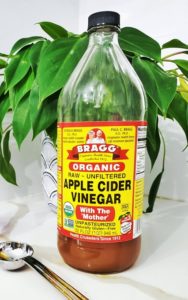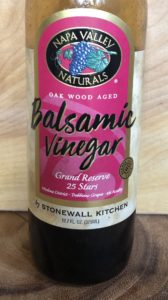 Why all the vinegar choices at the store?
Why all the vinegar choices at the store?
And, what about all those bottled salad dressings…can they be part of a healthy lifestyle?
Continuing our grocery store tours, we want to build on our last segment from the cooking oils section and take a trip to the vinegars and salad dressings sections.
Flavor up your meals!
 Vinegars add amazing flavor to meals and are great for our health (for thousands of years, vinegars have been used to treat all kinds of ailments). In our virtual tour, we provide tips on what to look for on the ingredient labels and explain various types of vinegars.
Vinegars add amazing flavor to meals and are great for our health (for thousands of years, vinegars have been used to treat all kinds of ailments). In our virtual tour, we provide tips on what to look for on the ingredient labels and explain various types of vinegars.
What is “the mother?”
We also shed light on “the mother” (which is a healthy bacteria that provides many nutritional benefits). If you have avoided the murky looking vinegar for the crystal clear version, you might want to rethink this approach!
Kick the bottle to the curb?
When it comes to salad dressings, be on the lookout for refined oils, salt, added sugars, and other ingredients that are included to extend shelf-life or add texture, color or flavor. There are some “better” options hiding on the shelves and, of course, the best option is to make your own.
A great place to start is our “go-to” homemade dressing — the key is to use good quality ingredients to make our “2-1-1!”
(2 Tbsp extra virgin olive oil + 1 Tbsp balsamic vinegar + 1 Tbsp dijon mustard).
And, of course, you can adjust to your taste such as 2-2-1!
Check out our video to learn more!
The key takeaways?
- Keep reading those ingredient labels!
- Embrace “the mother!”
- Prepare your own salad dressings! There are so many delicious dressings you can prepare in just a few minutes at home…stay tuned for more on this in next week’s coaching tip!
In the video, we mention we occasionally like to use an aged balsamic. A good aged balsamic has a thicker consistency (almost like a syrup) and a deep, rich flavor. It’s a great substitute for balsamic reduction and is fantastic drizzled on salads, grilled fruits, meats and all kinds of entrees! It is more expensive, so we tend to use “regular” balsamic in everyday cooking (like in our “2-1-1” salad dressing).
A couple of aged balsamic vinegars we really like include:
 Napa Valley Naturals Grand Reserve Balsamic (25 Stars)
Napa Valley Naturals Grand Reserve Balsamic (25 Stars)
Fustini’s 18-Year Traditional Balsamic Vinegar (Zonya’s favorite!)
What about sulfites?
Zonya Says:
To learn more about oils, vinegars and salad dressings, don’t miss these coaching tips:
Grocery Store Tour: Cooking Oils Are Not Created Equal!
The Pantry Staple That Gets Better With Age (vinegars)
Friends Don’t Let Friends Buy Bottled Salad Dressings
We hope these virtual grocery store tours are helpful and somewhat entertaining! Please keep those ideas coming and let us know what section of the store you want us to add to the list!
 LEARN MORE ABOUT THE NAPKIN!
LEARN MORE ABOUT THE NAPKIN!


Such excellent advice! That’s our favorite homemade dressing recipe too but I go with half oil and half vinegar, a small squirt of Dijon and a drizzle of maple syrup for the two of us. We’ve found that Fustini’s aged balsamic vinegar is excellent all on its own as a dressing, the flavor is that outstanding, or with just a little olive oil–nothing else needed. Thanks for another great shopping video!
Fabulous information that really shows how I can make better choices standing in a real grocery store aisle. I really love when you show us the brands and ingredient labels. Thank you! I wish you would have gone a little bit more in depth with the salad dressings! I feel like there are so many choices coming out that a actually pretty descent, but was glad to be pointed in Annie’s direction. Any others??? BUT, looking at the I ingredients I’m seeing “gums” in dressings that other wise have healthy oils and clean ingredients. Organic gum acacia, organic guar gum, xanthan gum, to name a few. Are these clean, okay, detrimental? Which ones should you avoid and which ones are okay?
Great Questions Amy! my go to is the CSPI Chemical Cuisine where they rate additives as Safe, Caution, Avoid and Some People should avoid, which is what they say about these gums. Read about it here https://www.cspinet.org/eating-healthy/chemical-cuisine#gums I hope this helps! And emphasizes that making your own is “gum free” and once you get into the habit, is darn easy!
Hurray! At last! Thank you so much for sharing the CSPI webpage, Zonya! I’ve been doing a lot of reading on ingredients this year and their list is certainly the most concise and helpful.